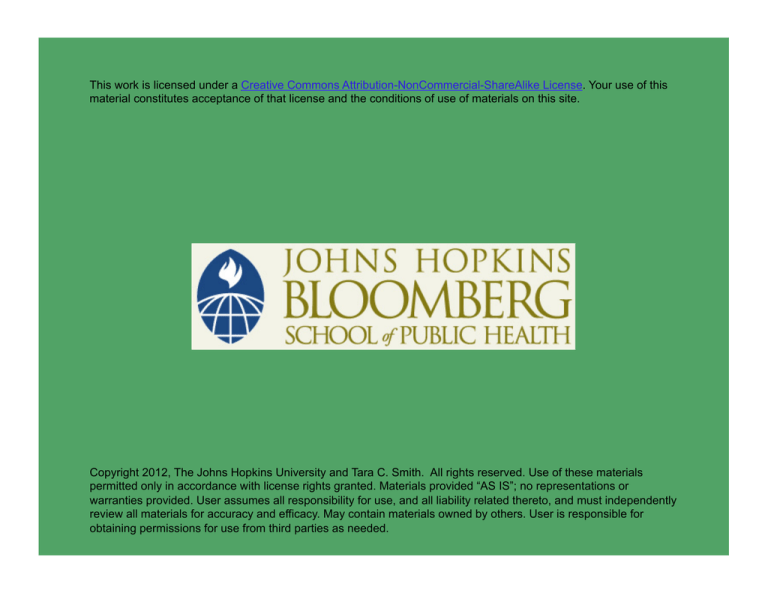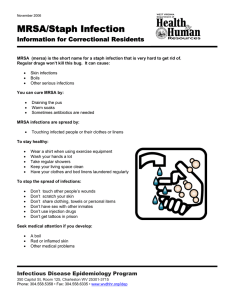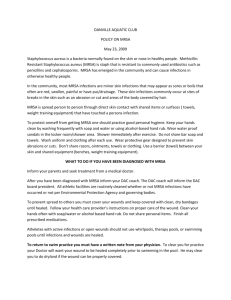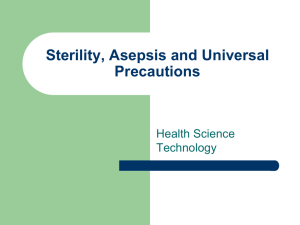
This work is licensed under a Creative Commons Attribution-NonCommercial-ShareAlike License. Your use of this
material constitutes acceptance of that license and the conditions of use of materials on this site.
Copyright 2012, The Johns Hopkins University and Tara C. Smith. All rights reserved. Use of these materials
permitted only in accordance with license rights granted. Materials provided “AS IS”; no representations or
warranties provided. User assumes all responsibility for use, and all liability related thereto, and must independently
review all materials for accuracy and efficacy. May contain materials owned by others. User is responsible for
obtaining permissions for use from third parties as needed.
Swine Farming and MRSA
Tara C. Smith, PhD
University of Iowa
Center for Emerging Infectious Diseases
Tara Smith
Associate Professor of Epidemiology, University of
Iowa School of Public Health
Co-director, Center for Emerging Infectious
Diseases
Bachelor’s in biology, Yale University
PhD in microbial pathogenesis, University of Toledo
Post-doctoral training in molecular epidemiology, University
of Michigan
Current research investigates the epidemiology of antibioticresistant Staphylococcus aureus in rural and farming exposures
Has written books on Ebola, Group A streptococcus, and Group B
streptococcus
3
Tara Smith
We’ll be discussing some work we’ve done looking
at swine farming and methicillin-resistant
Staphylococcus aureus
Iowa is the No. 1 pig-producing state (there are
about six-times more pigs than humans in Iowa)
We’ll look at swine farming as a potential reservoir
of MRSA bacteria in the state
4
Section A
Introduction to MRSA
Introduction to MRSA
Methicillin-resistant
Staphylococcus aureus (MRSA)
Gram-positive bacterium
Leading cause of hospitalassociated infections
Source: CDC
6
Introduction to MRSA
Approximately 30 percent of the population carries a strain of S.
aureus
About 1.5 percent are colonized with MRSA
There were 18,000 deaths and 94,000 invasive infections from MRSA
in 2005
Sources: Graham, P. L. 3rd, Lin, S. X., & Larson, E. L. (2006). Ann Intern Med, 144, 5, 318–325;
Kuehnert, M. J., Kruszon-Moran, D., Hill, H. A., et al. (2006). J Infect Dis, 193, 2, 172–179; Gorwitz, R.
J., Kruszon-Moran, D., McAllister, S. K., et al. (2008). J Infect Dis, 197, 9, 1226–1234.
7
Introduction to MRSA
Not only a hospital problem anymore
Now throughout community
- Schools
- Prisons
-
General population
8
Introduction to MRSA
Source: Kazakova, Hageman, Matava, et al. (2005). N Engl J Med, 352, 5, 468–475.
9
Introduction to MRSA
Source: CNN. Retrieved from http://www.cnn.com/2007/HEALTH/10/26/bacteria.staph/index.html
10
Introduction to MRSA
Source: Sing, A., Tuschak, C., Hörmansdorfer, S. (2008). N Engl J Med, 358, 11, 1200–1201.
Photo: PublicPhoto.org. Public Domain.
11
Introduction to MRSA
Photos are US Government Public Domain
12
MRSA and Swine
First identified in the Netherlands,
2005
Girl of 6 months found to have MRSA
upon hospital admission
Family lived on pig farm
Parents also colonized
Source: Armand-Lefevre, L., Ruimy, R., and Andremont, A. (2005). Emerg Infect Dis, 11, 5, 711–714.
13
MRSA and Swine
Twenty-six pig farmers swabbed; six
(23%) tested positive for MRSA
-
A rate 760-times higher than in
the general population
Pigs cultured
Same strain in pig and family
(“ST398” or “non-typeable” MRSA)
14
MRSA and Swine
Swine-associated MRSA also found in
Denmark, Germany, Austria, France,
Canada, Spain, Italy, Belgium,
Sweden, Dominican Republic, China,
Malaysia, UK, Switzerland, Portugal,
Finland
15






